Social media saturation is at an all-time high. Users are bombarded with more content than they can ever hope to sort through. For businesses with an audience on Twitter, this means it’s more important than ever to know and use the best hashtags Twitter has to offer.
Using hashtags can help you surface your Tweets and focus in on potential customers and loyal fans of your brand. In other words, hashtags can help you find your ideal audience.
In this article, we’ll give a brief primer on Twitter hashtags and their pros and cons. Then we’ll explore how to find the right ones for your business and get the most out of them. Let’s dive in!
An introduction to hashtags
Hashtags may sound a little mysterious if you’ve never spent much time with them, but they’re actually pretty simple. They’re essentially social media keywords – a hashtag is just a keyword with a pound (or hash) symbol in front. The hash signals the platform (Twitter, in this case) to index that keyword in a specific way.
Hashtags originated with Twitter way back in 2007, and they’ve been a social media mainstay ever since.
They enable Tweets to be filtered by related topics.
For example, if you Tweet about chocolate and use the hashtag ‘#ChocolateLovers’, your post will be visible to any hungry Twitter users searching for that tag.
Hashtags are also clickable, and doing so will take you to a list of all Tweets containing that tag:

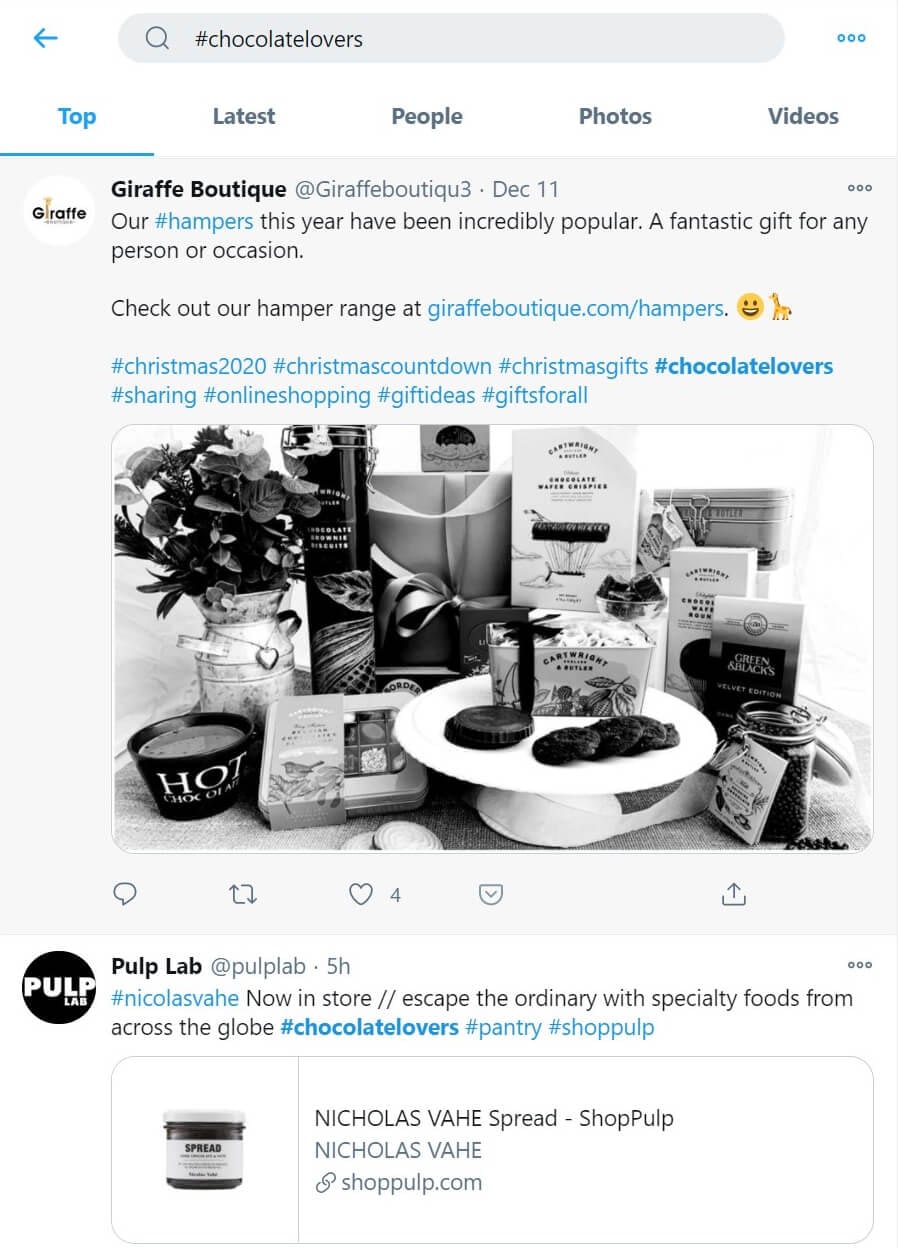
In this way, hashtags serve as a way to connect Tweets and posts among diverse users who might never connect otherwise, and turn the normal Twitter firehose into a more manageable and focused feed.
The pros and cons of using Twitter hashtags
Using the right hashtags can have a huge impact on the reach and visibility of your Tweets. Normally, your content on Twitter appears in the feeds of people who follow you, and if someone happens to share or retweet it, perhaps their followers will too.
However, as soon as you add a hashtag into the mix, the Tweet instantly becomes visible to anyone who searches for that hashtag, whether they follow you or not. Additionally, Tweets with hashtags consistently see double the engagement[1] of those without. If this engagement includes retweets, you expand your audience again to anyone who follows the retweeters. Hashtags can also be highly useful for branding if you can get one of your own to take off.
Of course, there are potential pitfalls here as well. Too many hashtags can actually be worse than not using any: Tweets with more than two hashtags actually show a drop in engagement compared to those with none.
Additionally, using too many hashtags (or using overly-generic ones) can dilute your audience, potentially causing your message to fall on deaf ears. Finally, using hashtags in Twitter ads can draw users away by encouraging them to click on and explore the hashtag, rather than the content you’re promoting.
The bottom line for most brands seems to be to use hashtags as often as possible. However, keep them to one or two highly-focused keywords per Tweet, and don’t use them on promoted ads.
How to get the most out of hashtags on Twitter
As we mentioned above, you should definitely be using hashtags. However, using them is one thing. Getting the desired result – increased visibility and engagement – is another story. If two is the maximum number of hashtags you should be using, you’ll want to make sure you’re using them properly.
First, be careful when creating your own hashtags. Although you can turn any keyword you like into one, people actually have to be searching for that keyword to see any benefit.
Also, keep your hashtags short and memorable. Don’t use any spaces or punctuation (aside from the hash symbol), as these can interfere with the hashtag or unintentionally change it into something you may not want. For example, you want to use ‘#ChocolateLovers’, rather than ‘#Chocolate Lovers’. The latter will only register the word ‘chocolate’ as the hashtag, and your Tweet won’t be indexed when people search for ‘#ChocolateLovers’.
On a similar note, you should definitely use capital letters in the right way to make your hashtags more readable. ‘#ChocolateLovers’ and ‘#chocolatelovers’ will both be indexed the same, but the former is much more clear. So-called ‘CamelCase’ hashtags will have greater visibility and readability.
Finally, keep an eye on new hashtags that seem to be going viral. Even if it’s outside your normal wheelhouse, it might be worthwhile to create a Tweet around a given hashtag if the exposure level is high enough.
How to find the best Twitter hashtags (4 tips)
At this point, you know what hashtags are, why you should be using them, and how to get the most out of them. The final question is: which hashtags should you use? These four tips should get you started.
1. Check trending hashtags
First, take a look at trending hashtags to see what’s relevant and popular on Twitter right now. The simplest way to do this is to browser Twitter’s own Trending section. First, head to Twitter and log in. In the left-hand sidebar, click Explore. This will pull up a list of trending topics and hashtags:
You can use the tabs at the top to filter what you see. Generally, though, you’ll want to stick to the Trending tab. This is the list of current trends across all topics. You can view trends globally or for a particular location by clicking the cogwheel icon next to the search bar.

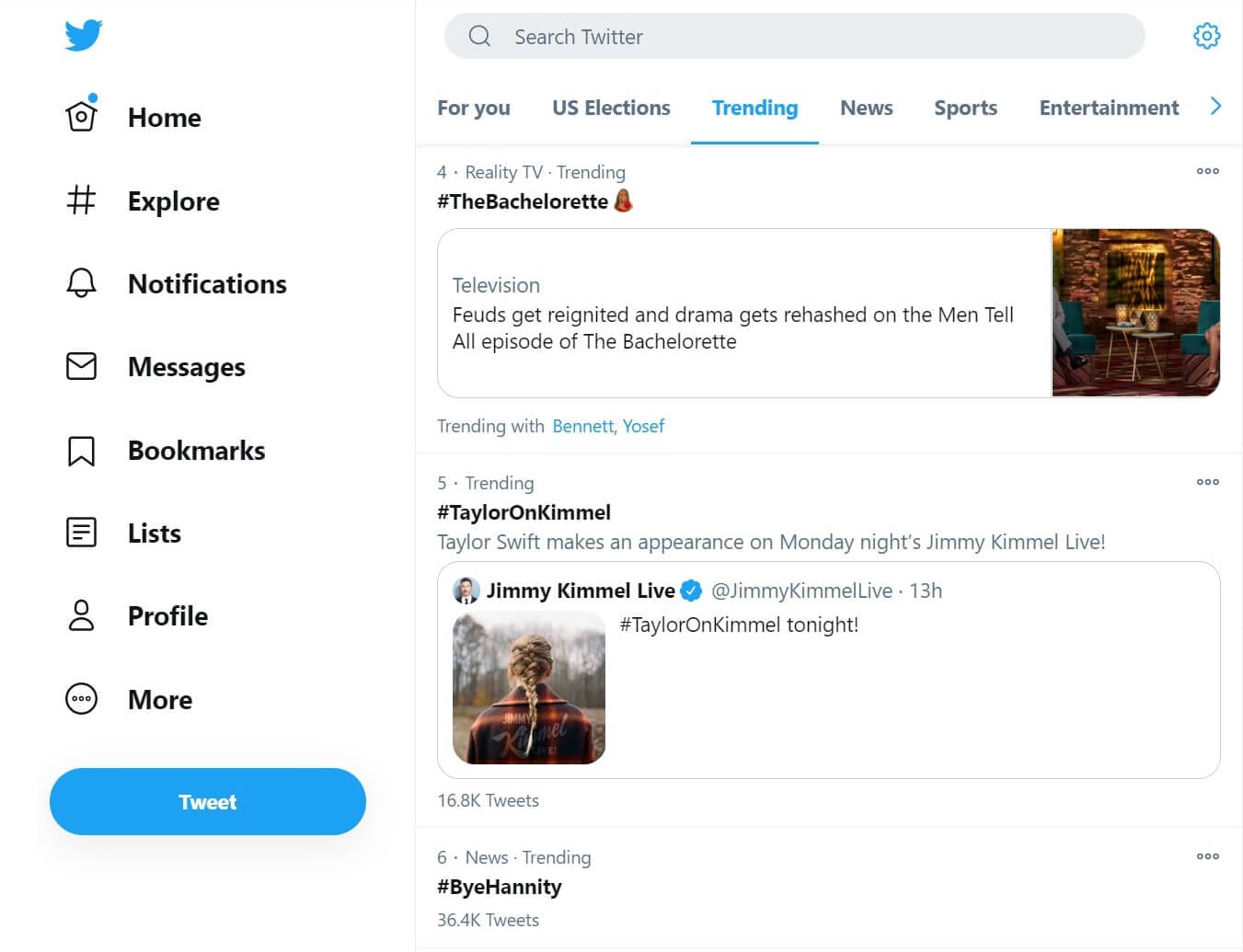
Keep in mind, not everything in this list is a hashtag – some items are simply topics. However, the hashtags are fairly obvious, since they’ll include the hash symbol. Each trend shows a rank, the number of recent Tweets, and the category it falls under.
2. Utilize tools to track visibility
Tracking general trends is a fantastic place to start, but there are also some third-party tools available that can show even more detail, such as Hashtagify:

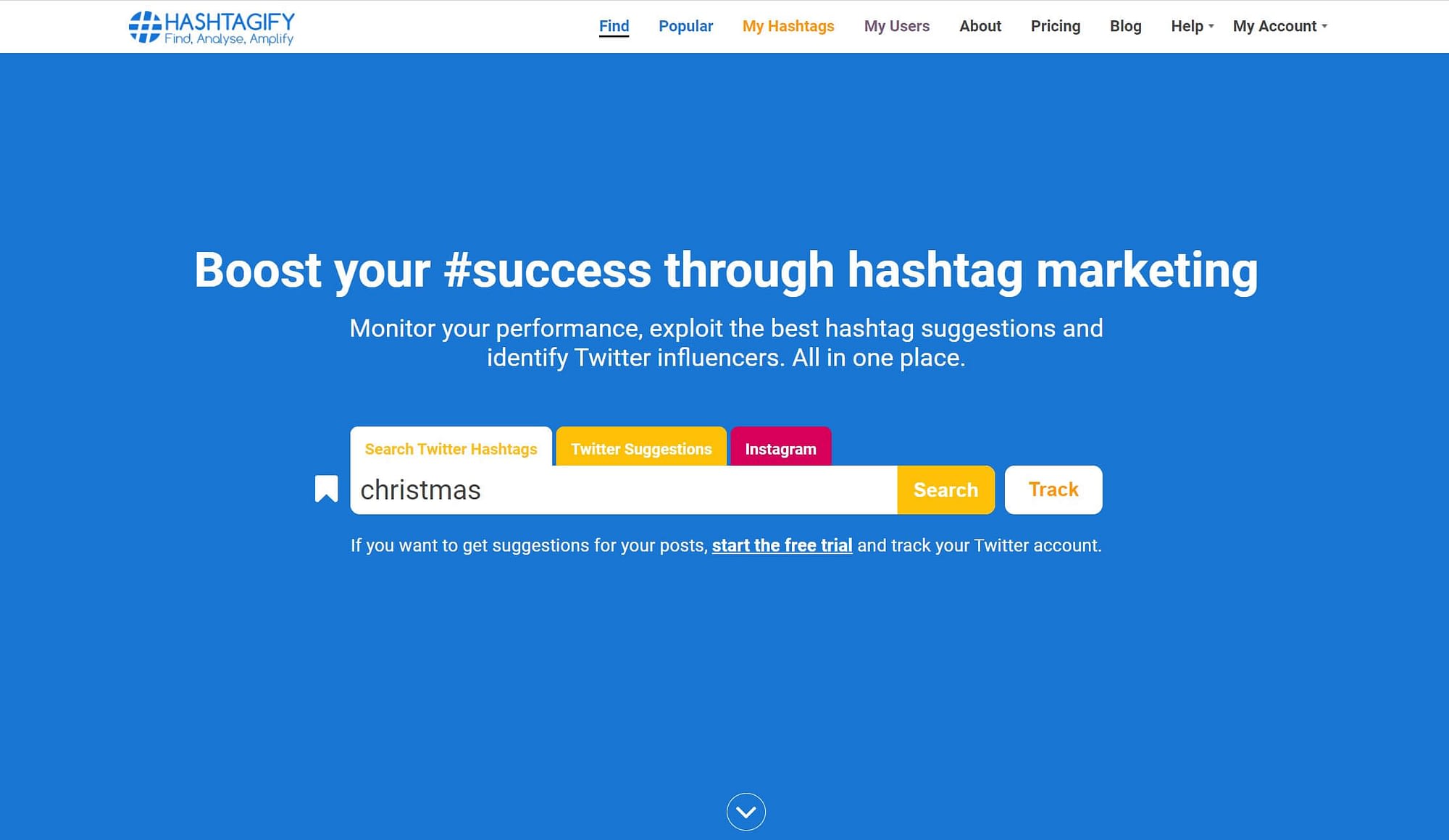
Search for a hashtag on Hashtagify and you’ll see a breakdown of related tags, top Tweeters for that tag, and more:

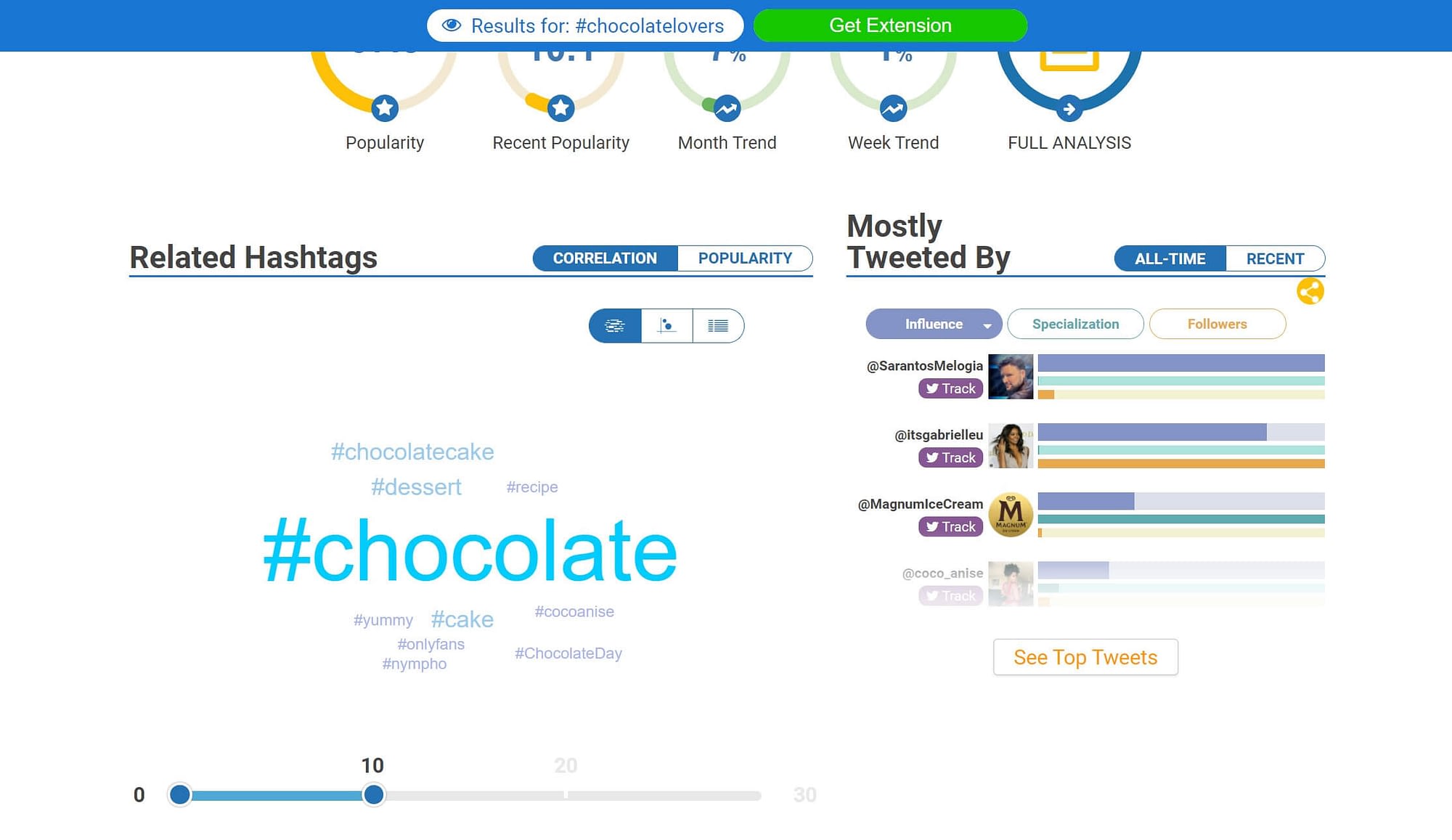
This information is very handy for selecting additional hashtags when you already have a primary in mind. It can also give you some profiles to check out, so you can see how others are using the tag.
Hashtagify also shows the popularity of the hashtag over time:

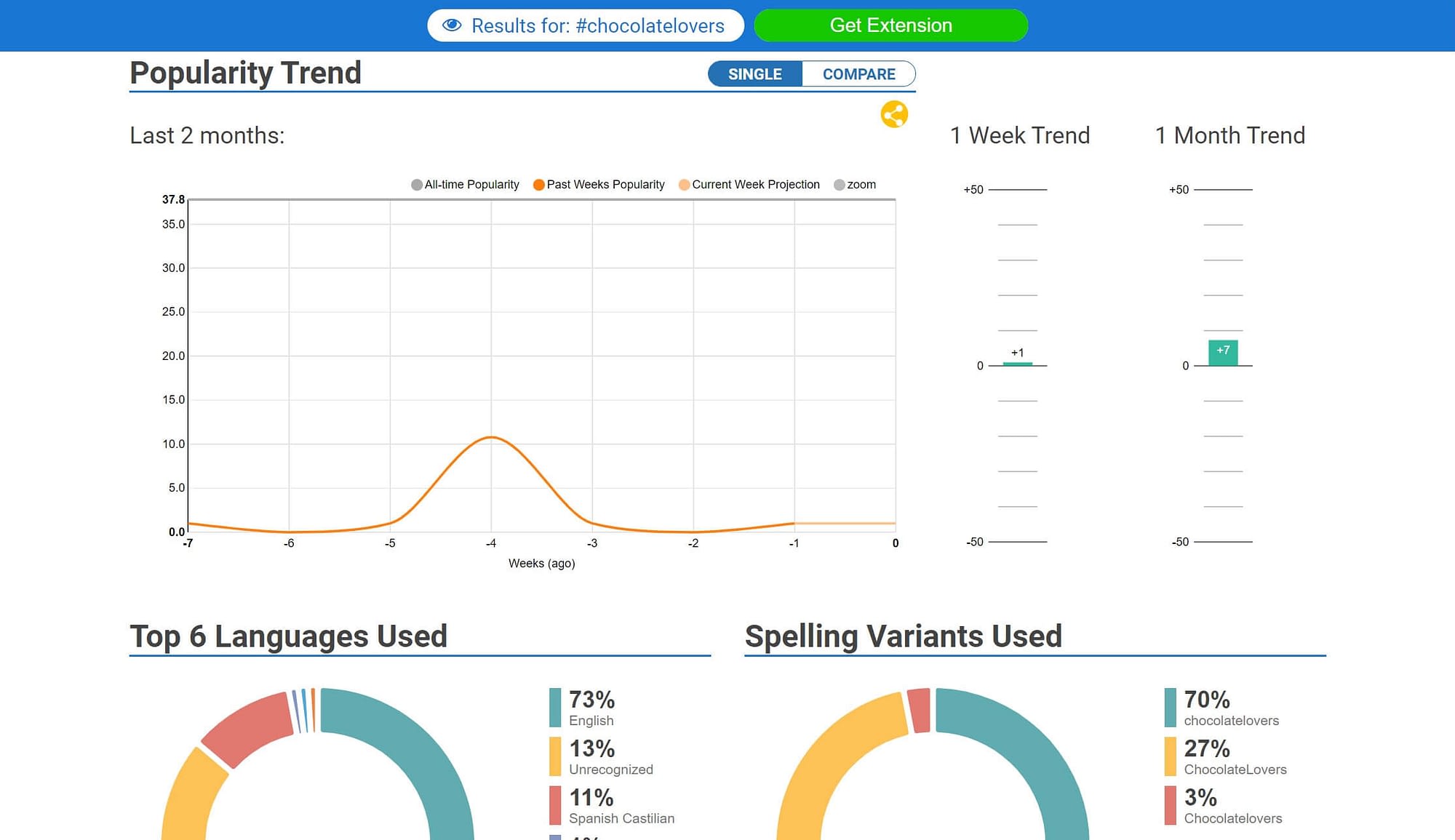
The tool even shows the top languages and spelling variants used, so you can make sure you phrase your hashtag in the most effective way.
Hashtagify offers a limited number of searches per week for free, but there are paid plans that expand its capabilities, as well as a browser extension to make monitoring trends even easier. If you don’t like Hashtagify, RiteTag and Trendsmap are also solid options.
3. Watch industry influencers
Another natural place to search for inspiration is with industry influencers. Again, tools like Hashtagify can show you top Tweeters for a given hashtag, but you’re probably already aware of who the primary thought leaders and competitors are in your space. As such, you should follow them and pay attention to what they Tweet.
If you aren’t sure who to follow here, consider doing some reverse engineering. Look at some of your own followers, scope out who else they’re following, and pay attention to the conversations they have. Eventually, you’ll see some patterns in who they follow. You can also try searching on forums, checking out Reddit and Facebook groups, and browsing other social sites for ideas.
The general rule of thumb here is that the more time you spend on the platform, the more familiar it’ll become. This makes it easier to pick out trends and influencers.
4. Leverage holiday hashtags
Holidays and special events like conferences are hashtag goldmines. If it’s Christmastime, find ways to utilize Christmas-related hashtags. If there’s a big industry event happening, it probably has a hashtag (like #SXSW). In short, leverage it!
Additionally, as the use of hashtags has gained traction, some common special hashtags have cropped up that are reused regularly on many platforms, Twitter included. Some of these include:
- #MondayMotivation
- #TransformationTuesday
- #TrendyTuesday
- #TBT or #ThrowbackThursday
- #FollowFriday
These are always popular, and relatively easy to jump on. There are also some hashtags that are quite general and always popular, so nearly any business can make use of them. These include:
- #HappyBirthday
- #Pets
- #Giveaway
- #Win
- #Thankful
- #Goals
Like the above, these are fairly easy to work into your Tweets, though you may need to plan your content around them a bit since they’re so generic. The general advice on choosing focus keywords applies in part here. Unique keywords are going to have less traffic associated with them, but a highly targeted audience. However, you need to balance this for the best split between targeted users, traffic, and visibility.
Conclusion
Standing out in a packed social media landscape is tough. In fact, at times it might seem impossible. Fortunately, there are tools to help, and hashtags are one of the most powerful. This free method for finding new users has immense potential, not just on Twitter itself, but right across social media.
Finding the best Twitter hashtags for your business isn’t as hard as it may seem. Utilize software tools to check on trending hashtags and those that get high long-term visibility. Check in on industry influencers and see what they’re using. Finally, make use of hashtags for special events and holidays to boost visibility even further.
Have any questions about using hashtags? Ask away in the comments section!
The post How to Find the Best Twitter Hashtags in 4 Steps appeared first on Revive Social.